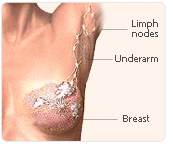
A great deal of evidence from observational studies, and also the Women's Health Initiative (WHI) shows that after menopause, women using combined estrogen and progestin hormones therapy (CHRT) are at increased risk of breast cancer. However, not many studies have assessed the impact of longer-term use of hormones therapy (HRT) use (more than 15 years) on breast cancer risk. One investigation found that using hormones therapy for 5 years or more was linked to an increased risk, but another stated that only using hormones therapy for 10 years or longer increases breast cancer risk. The purpose of this study is to analyze relationships between the duration of hormones therapy after menopause and risk of breast cancer.
Very little data is available on relations between hormones therapy use after menopause and risk of breast cancer by estrogen receptor (ER) and progesterone receptor (PR) status. In this review various factors were taken into account as potential contributors to breast cancer risk, including family history of breast cancer, type of menopause, and age at menopause. It was only adjustment for type of menopause that altered the risk estimates of the odds ratios (ORs), by more than 10%. Type of menopause was most probably a confounder because estrogen hormones therapy (ERT) is linked to an increased risk of endometrial cancer but combined estrogen and progestin hormones therapy (CHRT) is not. Thus, estrogen hormones therapy is more likely to be an option for females who have undergone a hysterectomy, and combined estrogen and progestin hormones therapy for women with an intact uterus.

Not many investigations have focused on the possible influence of hormones therapy use after menopause on rate of breast cancer by ER/PR status. One study reported that these associations were similar regardless of ER/PR status, but another found that women using hormones therapy (HRT) after menopause were more likely to have hormone receptor-positive tumors. Though, such studies did not differentiate between types of hormones therapy used after menopause.
It was observed that use of estrogen hormones therapy after menopause was not linked to risk of breast cancer of any ER/PR profile, but combined estrogen and progestin hormones therapy was associated with increases in risks of ER+/PR+ tumors, and that the scale of these risks increased the longer combined hormones therapy was used after menopause. Despite the fact that such findings need to be confirmed, they indicate that the progestin component of combined estrogen and progestin hormones therapy is particularly significant in terms of altering the risk of breast cancer. Observations imply that combined hormones therapy after menopause may promote breast cancer by stimulating both ERs and PRs, and not through the ER alone, given that use of this combined hormones therapy was linked to an increased risk of ER+/PR+ tumors, but not with a greater risk of ER+/PR- tumors.
Results suggest that use of estrogen hormones therapy post-menopause does not raise the risk of breast cancer in females aged between 65 and 79 years, even among those using estrogen hormones therapy for 25 years or more. A meta-analysis by the Collaborative Group on Hormonal Factors in Breast Cancer found that current use of estrogen hormones therapy for 5 years or longer after menopause was linked to a 1.34-fold increased probability of breast cancer.
More information is being gathered about the adverse impact on breast cancer risk of adding progestin to hormones therapy (HRT). Such an adverse impact is evident within several years of initiating use of hormones therapy. The data outlined above indicates that combined estrogen and progestin hormones therapy use after menopause is related to an increased risk of breast cancer, especially invasive lobular tumors.